Content of the article

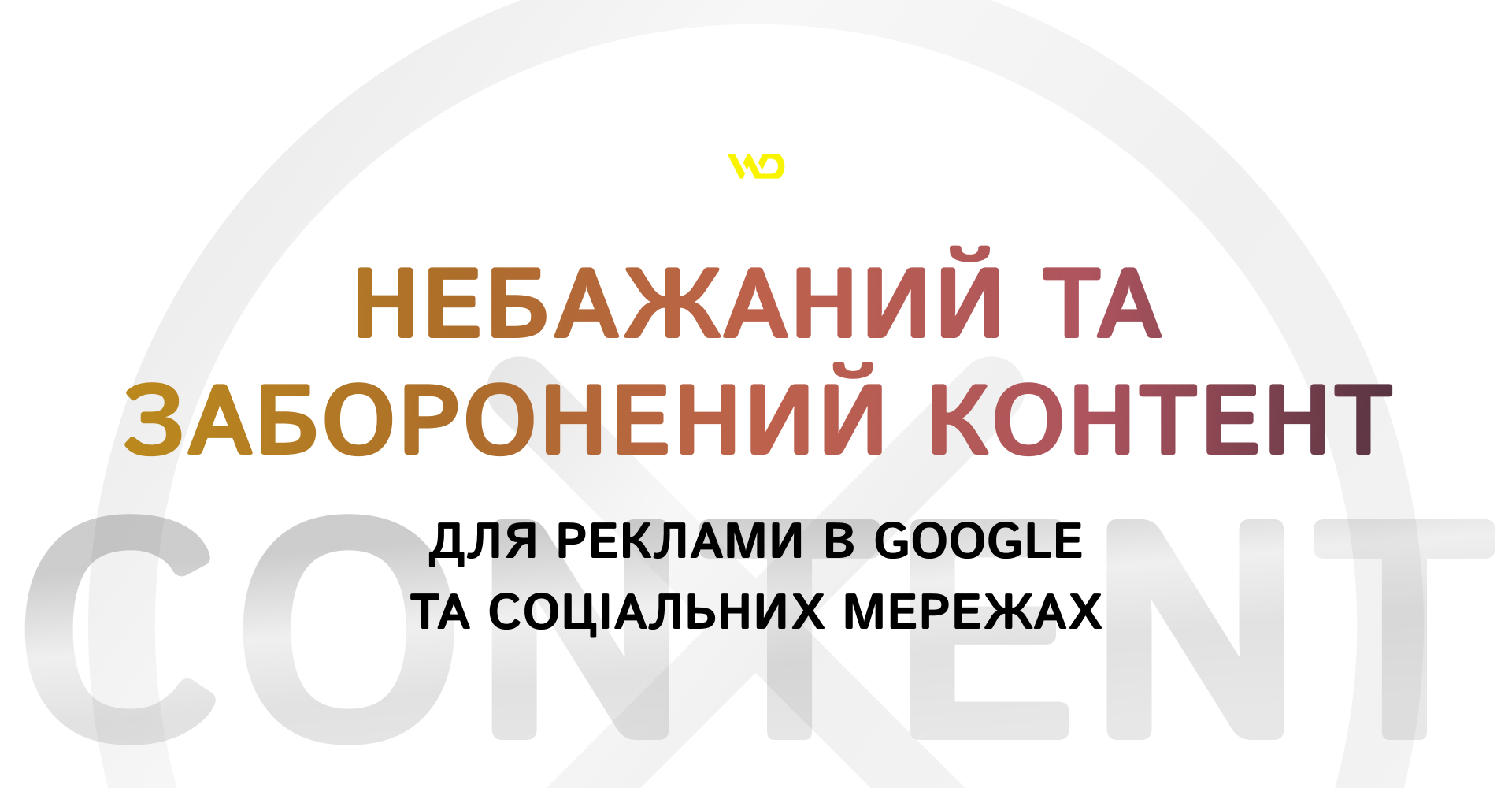
In today’s digital marketing, a proper understanding of what content is not only undesirable but also formally prohibited for inclusion in advertising campaigns is critical. Failure to comply with policies can lead to ad rejection, account blocking, or even legal consequences. In this article, we’ll take a closer look at the main categories of objectionable and prohibited content on Google Ads, Meta (Facebook and Instagram) , and TikTok, providing meaningful examples and comparing the platforms so you know exactly how to avoid risks and ensure the successful launch of your ad campaigns.
General principles of content prohibition
Once you understand what platforms consider «undesirable» and «prohibited,» you can immediately identify risky elements in your creatives and choose the right launch strategy. Below, we’ll break down the clear definitions of these categories and provide key features that help to identify inappropriate content on Google and social media.
The difference between junk and banned content
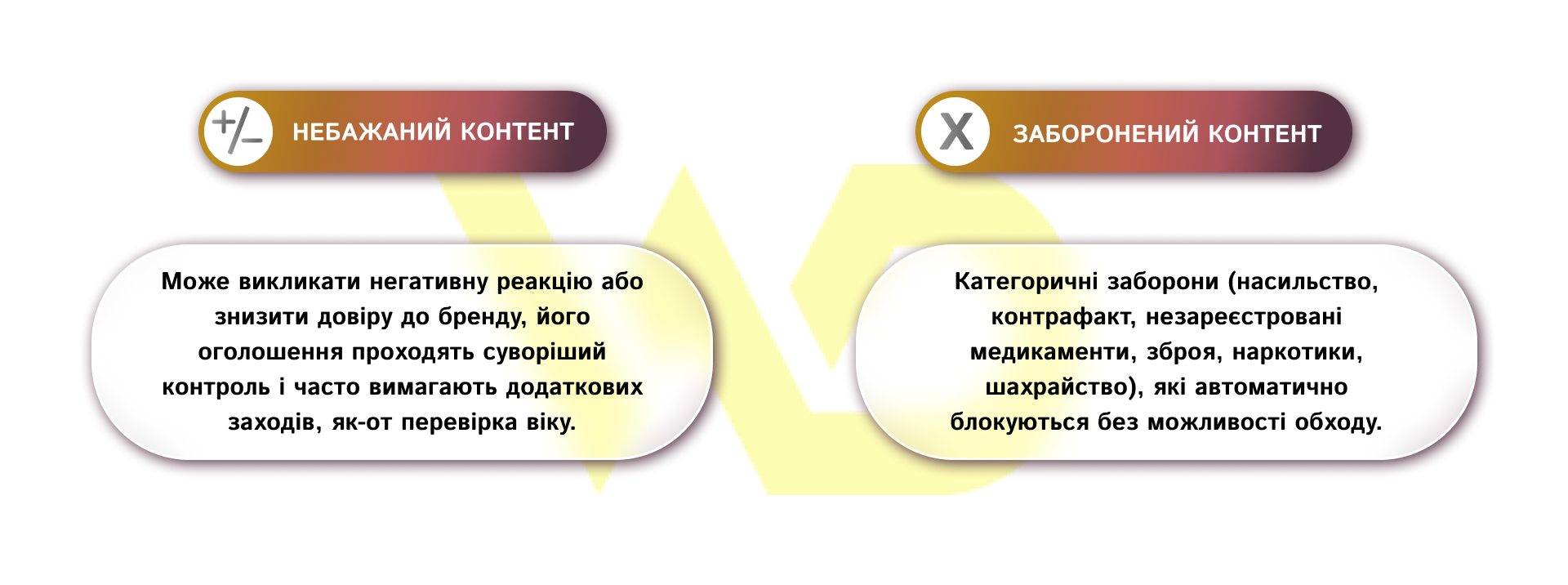
Unwanted content is material that can cause a negative reaction from the audience or reduce brand credibility. This includes shocking headlines, excessive nudity, or overly provocative images. Such ads are often subject to stricter moderation review and may require additional measures, such as age verification or disclaimers. Both elements help to comply with the requirements of advertising policies and reduce the likelihood of ad rejection or account blocking.
Prohibited content is a categorical «red flag» for any advertising campaign. The platforms automatically reject ads with calls for violence, sales of counterfeit products, unregistered medicines, weapons, drugs, as well as any fraudulent schemes that promise incredible benefits without risks. Advertisers have no way to circumvent these restrictions – such campaigns are blocked at the initial scanning stage.
Proper advertising is not only about moderation, but also about business security.
Entrust the configuration of contextual and targeted advertising to the WEDEX team — we will ensure that your campaigns pass verification without the risk of blocking and bring results.
Regulatory framework and official sources
Understanding where to look for current regulations and how often to check them is the key to the safe and successful launch of any advertising campaign. Below is a detailed overview of the main guides of each platform and tips on how to stay up to date.
- Google Ads Policies.
Google publishes its policies in the official Advertising Policy Guide, which contains sections on:
-
- Prohibited content – categories in which ads are rejected without the right to correct (for example, counterfeit, unregistered drugs, extremist appeals).
- Restricted content – goods and services that can be promoted only under certain conditions (pharmaceuticals, alcohol, gambling).
- Editorial & technical requirements – the rules for designing titles, descriptions, URLs, images, and videos.
- Requirements for landing pages (Landing page experience) – compliance with the content on the website, absence of hidden blocks with prohibited material.
- Google Ads Transparency Center.
In addition to the main guide, Google maintains the Transparency Center, which contains Product Terms for each service, including Ads. Here you can quickly find the latest version of the policy and the history of changes.
- Meta (Facebook/Instagram) Advertising Standards.
Meta publishes detailed advertising standards in the Business Help Center, which has separate sections:
-
- Prohibited content – categories that are prohibited for all ads (hate speech, violence, fraud, etc.).
- Restricted content – goods and services that require additional verification or disclaimer placement (alcohol, financial products, political advertising).
- Targeting restrictions – restrictions on audiences (age, demographic, behavioral), etc.
- Meta also maintains the Transparency Center for Social, Election and Political (SIEP) ads, which describes the requirements for the «Paid for by» disclaimer and verification procedures.
- TikTok Advertising Policies.
TikTok posts its policies in the Help Center section, where available:
-
- The main principles are honesty, security, and compliance with the laws of the target market.
- Prohibited content – clearly prohibited topics (weapons, tobacco, unregistered dietary supplements, adult content).
- Restricted content – regulated goods and services (medical products, finance, gambling) that require additional verification and age targeting.
- Additionally, you should familiarize yourself with the technical requirements for advertising formats and functionality.
To keep up to date with the latest changes in advertising policies, we recommend subscribing to the official blogs and RSS feeds of the platforms. For example, you can add Google Ads Developer Blog, Meta for Business News, and TikTok for Business Blog to your feed. Even if your creatives are fully compliant today, it is equally important to check the «Recent Updates» section in the respective directories at least once a quarter to help you adjust any changes in advance before launching new campaigns and minimize the risk of rejection or blocking. In addition, create internal checklists based on the key categories of «Prohibited» and «Restricted» – they will be useful for quick and systematic verification of all future ads.
Moderation process
Ads are usually moderated in two stages. First, automated systems based on machine learning scan the demo and text elements of the creative: headlines, descriptions, URLs, images, and videos. Algorithms match the content with keywords and images, identifying potentially problematic topics. If the automated check detects non-compliance with policies, the ad can be rejected without further human intervention.
In cases of questionable or high-risk content, a manual reviewer is involved in the process. The moderator checks the context of the ad: whether the information is presented correctly, whether there are any manipulative wording or hidden appeals.
For example, an ad that automatically contains the word «diabetes» in the phrase «miracle oil for diabetes» will be rejected. After that, a manual reviewer may recommend replacing «for diabetes» with «for maintaining health in diabetes» and adding a disclaimer that the product is not a medicine.
Appeal and correction mechanisms
If your ad is rejected, you should use the official appeal channels of each platform.
- Google Ads. In the interface, next to the «Rejected» status, there is a button «Request a second review». Once clicked, the system will queue the ad for a second automated review – sometimes with an additional manual review.
- Meta (Facebook/Instagram). In the Ads Manager section, find the Support tab – Appeals and fill out the form, specifying the ad ID and a description of the changes. The system will allow you to attach a comment and even screenshots of the corrected elements.
- TikTok. In the Ads Center, go to Support or use the support web form in the Help. They usually respond within 24-48 hours and give recommendations for improvements.
In your appeal request, please describe in detail what elements you changed (text, images, landing page) and why the content now complies with the policies. This will speed up the review and increase the chances of approval.
Geographical and regulatory specifics
In addition to global bans, each jurisdiction may impose additional restrictions under national law.
CBD products
In the United States, the sale of cosmetics or dietary supplements with cannabidiol is allowed under federal regulations, while in many EU countries, advertising may be absolutely prohibited. In Ukraine, advertising of products containing cannabidiol (CBD) is currently prohibited under the Law on Narcotic Drugs, Psychotropic Substances and Precursors.
Gambling
In the US, the rules depend on the laws of each state: some states do not allow online gambling at all, while others require a separate license. In Europe, there are European Commission directives that require local accreditation of operators and clear age-gates on websites. In Ukraine, advertising of online casinos, bookmakers and lotteries is allowed only to licensed operators and only in places specified by law (television – from 22:00 to 07:00, Internet – no age limit, but with a clear age limit and a link to the license).
Medicines and dietary supplements
In some Asian countries, any advertising of dietary supplements or herbal extracts requires prior regulatory approval. In Ukraine, according to the Law «On Advertising», advertising of medicines must contain information on mandatory consultation with a doctor and dosage information . Advertising materials for biologically active supplements should not contain medical claims and should include the disclaimer «Not a medicine».
Alcoholic beverages
At the international level, the WHO, as part of the SAFER initiative, calls for the restriction of any advertising that promotes alcohol consumption among young people. In the United States, the rules are regulated by the Alcohol and Tobacco Tax and Trade Bureau (TTB): It is forbidden to use images of minors or statements about «health and success» from drinking alcohol in creative. In the European Union, the Audiovisual Media Services Directive prohibits the advertising of alcoholic beverages during children’s and youth programs and requires the placement of a responsible message. In Ukraine, alcohol advertising is allowed only from 07:00 to 23:00, with the age label «18+» and a mandatory age-gate and disclaimer about the dangers of excessive consumption.
Tobacco products and electronic devices (vapes)
Under the WHO Framework Convention on Tobacco Control (FCTC), all tobacco advertising, including image campaigns and sponsorships, is prohibited. In the United States, the FDA controls vape advertising through the PMTA rule: companies must prove the safety of their products, and marketing with attractive flavors to young people is strictly limited. The European Tobacco Products Directive (TPD) bans cigarette and vape advertising in all media, allowing only neutral warning messages on packaging. In Ukraine, the Law «On Protection of the Population from Harmful Effects of Tobacco Smoke» prohibits any advertising of cigarettes, vapes and other nicotine products, both online and in traditional media.
Political advertising and social topics
In many countries, political advertising is required to be clearly labeled and disclose its sources of funding. In the United States, the Federal Election Commission (FEC) requires that advertisers indicate «Paid for by» and register as a political advertiser; advertising activity is strictly controlled by time frames. In the European Union, the Digital Services Act and the Audiovisual Media Services Directive set requirements for transparency of advertisers in digital media and prohibit microtargeting without explicit user consent. In Ukraine, political ads must be labeled «Political Advertising», contain information about the customer and costs, and their placement is regulated by the Laws «On the Election of the President of Ukraine» and «On the Election of People’s Deputies».
Compliance of the landing page
Prohibited or undesirable elements should not appear not only in the text of the ad, but also on the landing page. Even hidden blocks or meta data with inappropriate information will automatically disqualify your campaign. Make sure that all sections of your website meet the platform’s requirements.
Such a comprehensive approach to understanding the general principles of content prohibition will help advertisers minimize risks, reduce moderation time, and increase the effectiveness of their campaigns.
Prohibited content in Google Ads
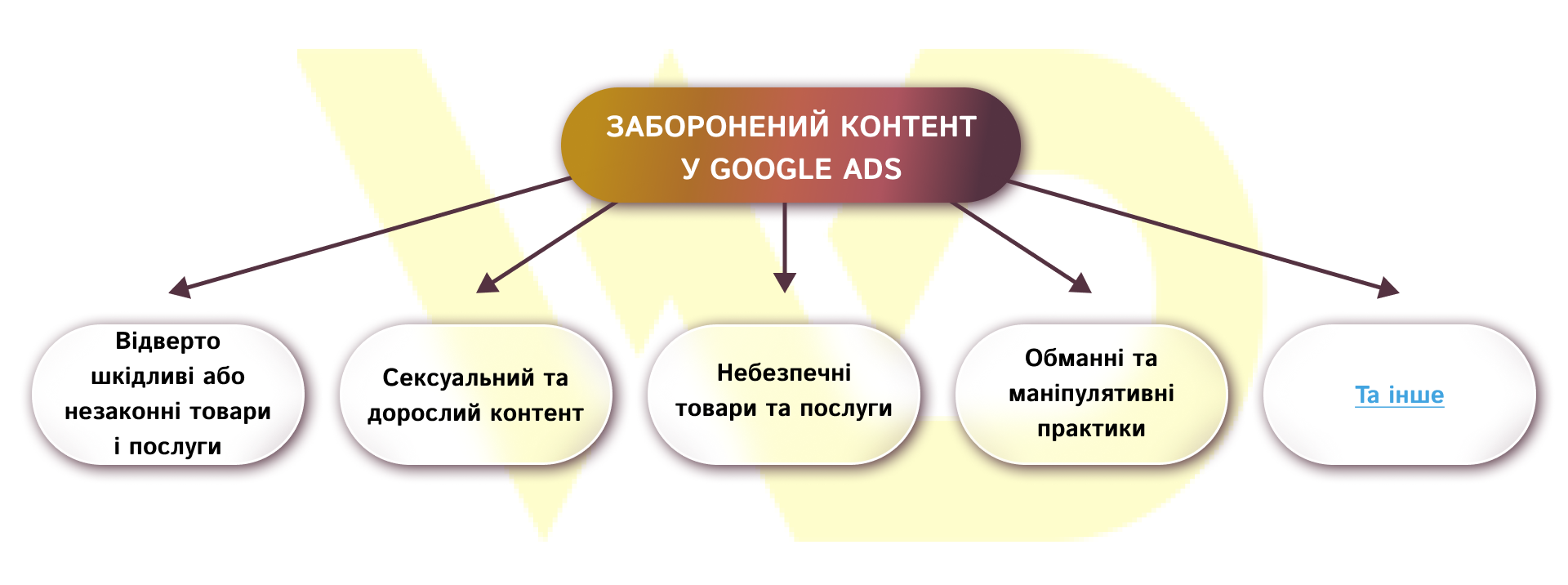
Google strictly regulates the topics that cannot be promoted through its advertising network in any way. Any ad that contains prohibited content is automatically rejected and is not subject to any customization or certification.
Unacceptable categories of goods and services
This group includes products and services that Google considers to be outright harmful or illegal. These include counterfeit products with fake brands, items related to extremist activities, and any calls or materials that support violence and radicalism. If your ad or landing page showcases a similar product or service, it will be rejected before the ad is shown.
Sexual and adult content
Google prohibits the display of any graphic sexual scenes, including pornography, animation, or deep fakes created for erotic effect. Content with sexual services (for example, escort ads) and materials that objectify minors are also prohibited. Even if such content originates from «mature» creativity, it cannot be used in advertising creatives or on landing pages.
Dangerous goods and services
Promotion of products that can harm health or safety is automatically prohibited. These include explosives, firearms, combat or sporting knives, pyrotechnics, as well as narcotic and psychoactive substances (including equipment for their use). Instructions for the manufacture of explosives or drugs also fall under this prohibition.
Deceptive and manipulative practices
In this section, Google has combined offers that mislead the user or are aimed at fraud. This includes «get rich quick schemes», fake documents, traffic or like services, and hacking or surveillance tools.
For example, fictitious financial services with the words «guaranteed profit of 500%» are automatically rejected.
Prohibited content in Meta (Facebook and Instagram)
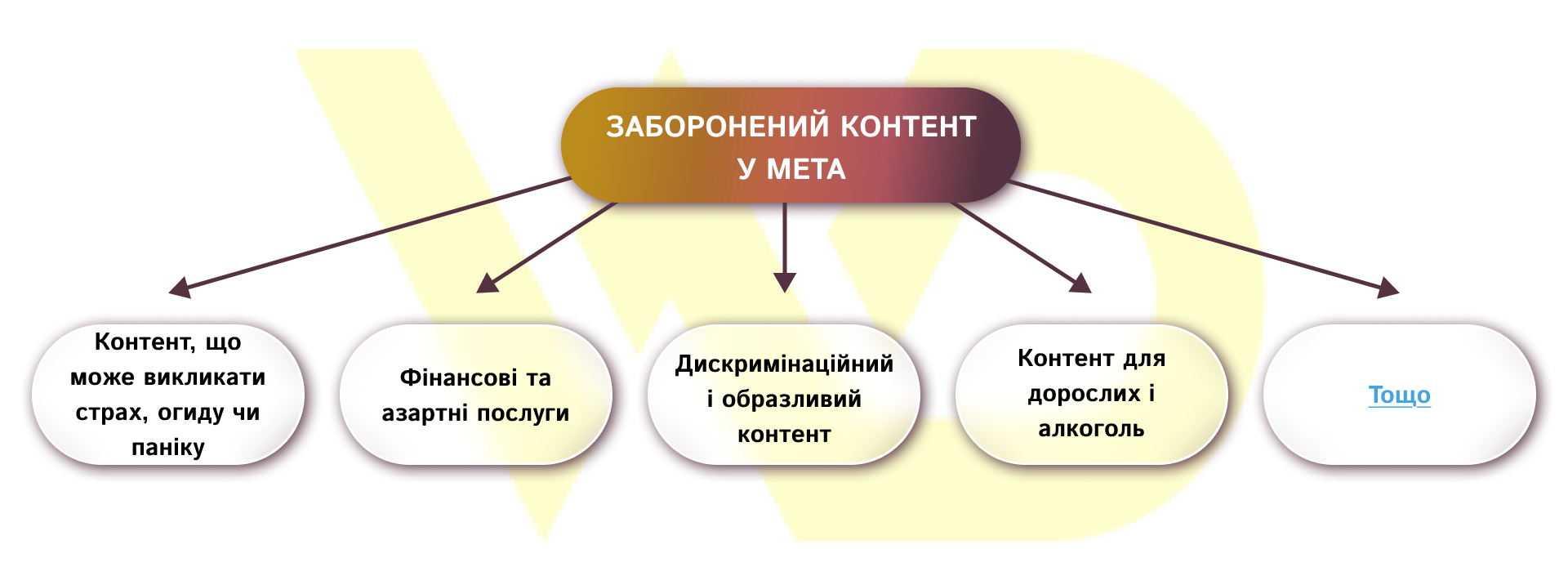
Meta strictly regulates the content of ads to ensure a safe environment for users. The platform has a clear list of topics prohibited for promotion.
Inappropriate content
Meta prohibits the use of sensational, shocking, or overly graphic content that may cause fear, disgust, or panic. For example, images of injuries, surgical interventions, disasters, or violence are prohibited, even in the context of warnings or public service announcements.
Financial and gambling services
Advertisements for microfinance organizations (MFO), unlicensed financial schemes, trading, or cryptocurrencies that are not officially regulated may be rejected or require prior permission. Advertisements for cryptocurrencies or exchanges require verification of compliance with local laws.
Discriminatory and offensive content
Meta blocks any content that contains hate speech, harassment, discrimination based on race, gender, age, orientation, disability, or nationality. Even indirect calls for isolation, restriction, or hostility are prohibited.
Adult content and alcohol
Any nude elements (even partially), sexual content or calls for dating with erotic overtones are prohibited. Alcohol advertising is allowed only with age restrictions and, in some countries, only with confirmation of the audience’s age.
For example, ads promoting «unhealthy diets» or «extreme procedures» will be rejected.
Prohibited content on TikTok
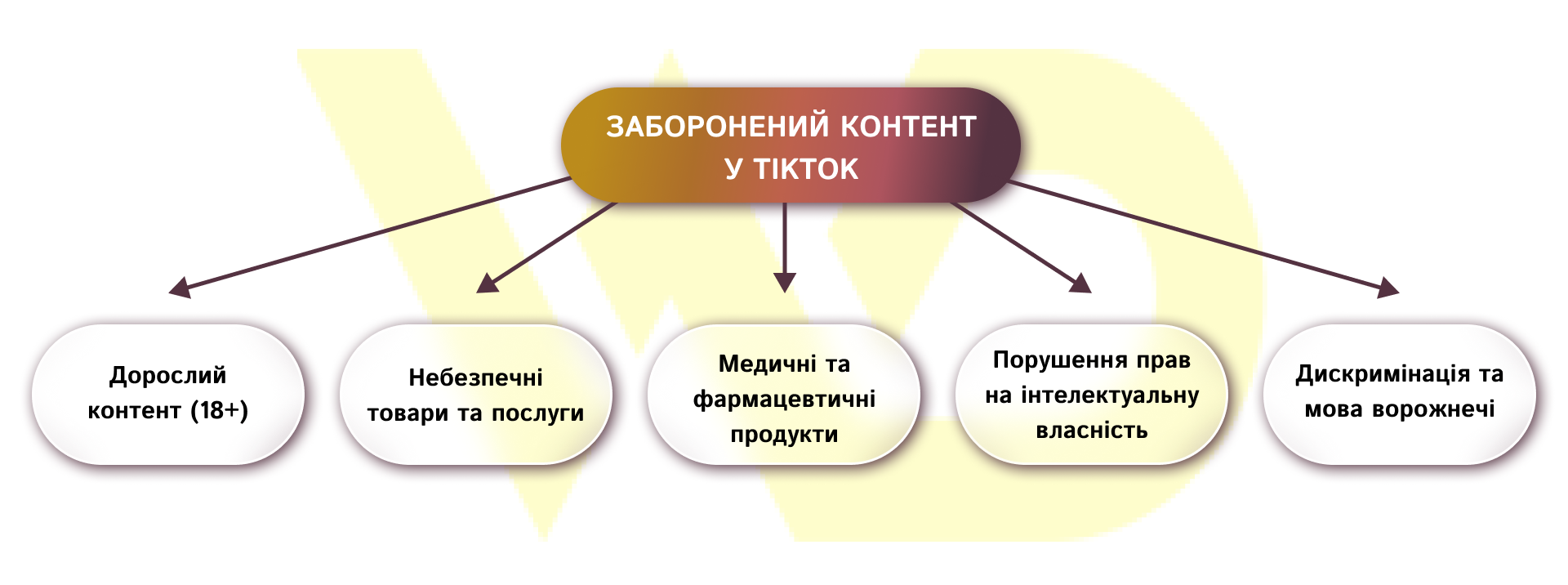
TikTok is aimed at protecting the young audience, so the platform’s advertising policy is very strict. Below are the main categories of prohibited topics.
Adult content
TikTok strictly prohibits the posting of any content of a sexual nature, including erotic images, dating proposals, or intimate topics. Content that hints at nudity or has provocative overtones is also not allowed for promotion.
Dangerous goods and services
TikTok prohibits advertising firearms, knives, pyrotechnics, explosives, and any items that may pose a threat to life or health.
Medical and pharmaceutical products
It is forbidden to advertise prescription drugs, as well as dietary supplements or «miracle cures» whose effectiveness is not scientifically proven. Any medical claims must be documented.
Intellectual property
The platform does not allow the promotion of counterfeits, pirated software, or goods in violation of trademark or copyright rights.
Discrimination and hate speech
TikTok strictly prohibits discrimination, hate speech, and any manifestation of hostility, regardless of the form of presentation – text, video, subtitles, or images.
For example, a commercial promoting knives as a gift or a product for daily use will be automatically rejected, as TikTok considers it a violation of the Dangerous Items Policy.
Comparative analysis and key differences
Bans in advertising policies have common features, but each platform sets its own nuances that should be taken into account when planning campaigns.
Common categories of bans
All platforms – Google, Meta (Facebook/Instagram), and TikTok – do not allow
- sexually explicit content;
- shocking or violent content;
- deceptive and manipulative practices;
- sale of dangerous goods;
- discriminatory statements or hate speech.
These categories are the basic level of security, and violation of the rules in any of them is almost guaranteed to result in the rejection of the ad or account blocking.
Platform-specific features
Each advertising ecosystem has its own priorities and areas of increased attention.
Google Ads pays special attention to the quality of landing pages (compliance with ad promises, loading speed, absence of aggressive pop-ups).
Meta (Facebook/Instagram) has stricter requirements for political and financial content, additional checks and restrictions for advertising investments, cryptocurrencies, and election campaigns.
TikTok emphasizes copyright protection, particularly for music, as well as the aesthetics and safety of dynamic video content. The platform is sensitive to visual style, presentation style, and even indirect hints of restricted content.
Recommendations for advertisers
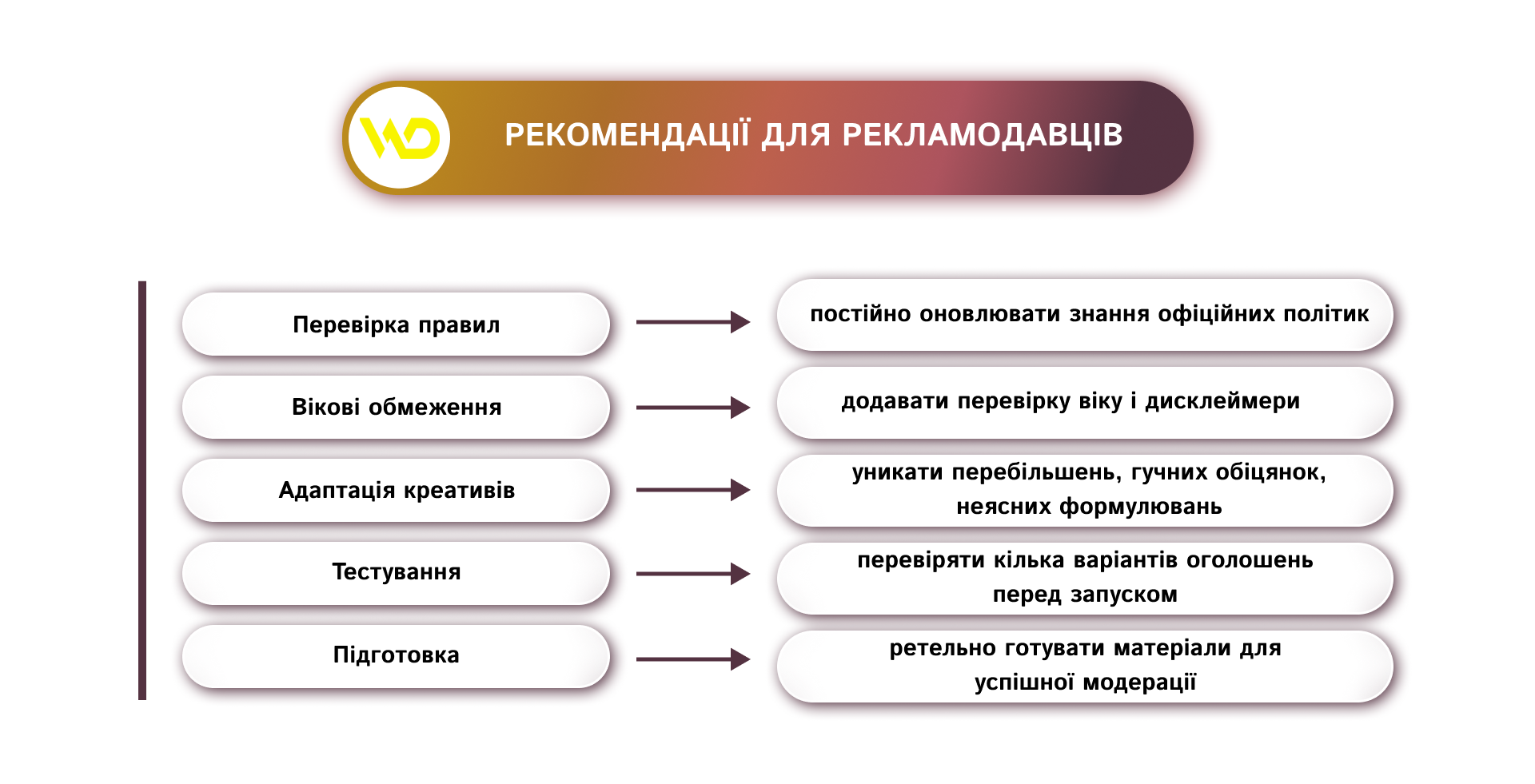
To avoid ad rejections, advertisers should always check the current rules for their category in the official platform guides – especially when it comes to sensitive topics such as health, finance, or politics. In cases where the content has age restrictions or potentially controversial topics, it is advisable to add age-gates or appropriate disclaimers in advance to minimize risks. It is also important to adapt creatives in accordance with the policies of each platform – avoiding loud promises, exaggerations, and unclear wording. Testing several variants of ads and thoroughly preparing materials before launching a campaign is not only a guarantee of successful moderation, but also a manifestation of a professional approach to promotion.






 30/09/2025
30/09/2025  1464
1464



